American history is chock-full of dark figures and cold-blooded killers. Possibly none more unnerving and perplexing than the infamous “Black Widow,” Belle Gunness.
The story of Belle Gunness is both fascinating and terrifying. From her modest beginnings in her early life to her gruesome crimes, then unexplained disappearance, Gunness holds a particularly unique place among her deadly peers.
A woman who defied all expectations, she evolved into one of the most notorious female serial killers in history. Gunness lived a life of secrecy and darkness, leaving a trail of death and disappearances behind her as she lured unwitting men to their ends.
What motivated her to commit such violent acts? Was she simply a cold-blooded killer or a victim of her circumstance? Was she searching for a way out through violence, or was it something else entirely?
Underneath all the lies, violence, and unsolved mysteries, the core question is: Who was this enigmatic, inscrutable figure we remember today, the mystifying serial killer, Belle Gunness?

Early Life and Immigration to the US
Belle Gunness, formerly Brynhild Paulsdatter Storseth, was born on the 11th of November 1859. She was born into a large family in the quaint area of Selbu, Norway. She was the youngest of eight children, the daughter of Paul Pedersen Storseth, a stonemason, and her mother, Berit Olsdatter.
Throughout her childhood, her family lived on a small cotter’s farm. Everything indicates that Gunness had a normal, uneventful childhood. However, some unverified stories tell of a traumatic incident that occurred when she was a young woman.
In 1877, she was attacked and assaulted by a man, resulting in the loss of her unborn child. Such an event, if true, would certainly leave a lasting mark on her.
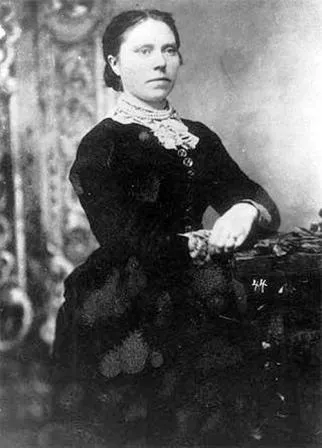
Gunness grew up poor and she worked for years to save up so that one day she could emigrate to the United States. In 1881, when she was 21, she finally left her humble beginnings in Norway in search of a better life.
Upon her arrival in the US, she settled in Chicago, changing her name to Bella Petersen and working for a time as a servant. This would be her life for a few quiet, unremarkable years.
Unbeknownst to anyone, that was all about to change. What followed was the beginning of a long, haunting journey of an unsuspecting Norwegian-American woman that developed into one of America’s most infamous serial killers ever.
Gunness’ First Victim
In Chicago, Belle Gunness married a fellow Norwegian named Mads Sorenson in 1884. The couple came into some money two years later and opened a confectionery store. Suspiciously, their new home burned down within a year, and with the money they claimed from the insurance, they were able to open the shop.
However, the confectionary store also burned down within a year, and they received yet another insurance payment. They used this to buy a home in Austin, Illinois this time. Gunness and Sorenson seemed to be willing to scheme and defraud to improve their lot.
Whether or not the couple had children is a subject of debate. But, official census data supports the claim that Gunness and Sorenson had four children. Whether they were their own or foster children, is still unclear.
Two of the four, Caroline and Axel, died in infancy due to acute colitis, a condition that could also be caused by poisoning. Like with the house and confectionary store, the insurance company paid out for their deaths.
Not long after that, Gunness’ husband, Sorenson, died on July 30, 1900. Coincidentally, he died on the same day on which his two life insurance policies overlapped. The coincidences didn’t stop there. Just before his death, Gunness had claimed Sorenson’s life insurance policy was too small and implored him to take out another, larger plan.
Although the family doctor concluded his death was caused by heart failure, another suspected strychnine poisoning – a method that will reappear throughout Gunness’ story. She applied for the $8,500 in insurance money the day after his funeral. His relatives accused her of poisoning him for the money, so she used the sum to buy a farm in Indiana and fled town.
In November 1901, Belle, along with three of their supposed foster children – Jennie, Myrtle, and Lucy – uprooted and moved to La Porte, Indiana. This would mark the end of one lethal chapter of Gunness’ life, but lead straight into another, deadlier era.
Life in LaPorte
Belle Gunness moved to LaPorte and married another fellow Norwegian, Peter Gunness, in April 1902. His wife had recently died, leaving him with two young daughters. This would be no happy affair, though.
Within a week of their marriage, the youngest of Peter’s daughters passed away under suspicious circumstances. And eight months later, Peter also died under mysterious circumstances. It was beginning to seem that everyone who found themselves around Belle Gunness would, sooner or later, be found dead.
While Belle claimed that Peter was accidentally hit in the back of the head by a sausage grinder, many believed that she was responsible for his death. Additionally, Belle’s daughter Jennie was overheard soon after telling a friend that her mother had killed her brand-new stepfather.
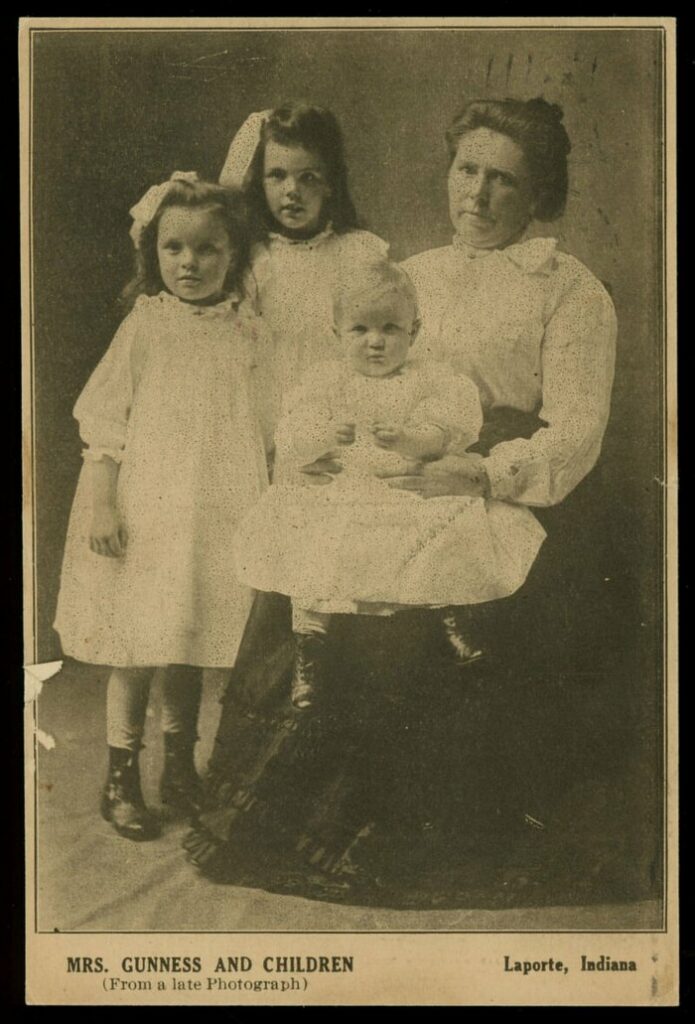
It is unsurprising then that, although Belle Gunness would never be found guilty of Peter’s death, Jennie would “go away” to boarding school a short time after the ordeal. Jennie too was eventually found dead and buried on the property. Peter’s older daughter, Swanhilde, was the sole child to have survived her time with Belle. She was taken to Wisconsin by Peter’s brother, Gust, a year later.
After Peter’s death, Belle placed ads in several Norwegian language newspapers throughout the Midwest, seeking a good and reliable man to become her partner on the farm. Many men came to visit Belle at her McClung Road farm, and many of them became her victims.
Belle Gunness’ Many Suitors and Many Victims
Her suitors brought offers of assistance, companionship, and importantly, cash, to her farm. But almost all of them would disappear forever. The list of potential victims includes John Moo, Henry Gurholdt, Olaf Svenherud, Ole B. Budsburg, and Olaf Lindbloom, to name a few.
In 1907, Belle hired a man named Ray Lamphere to help her maintain the farm. Among her many suitors, Ray would stick around for quite some time. Later that year, Gunness also employed the help of Andrew Helgelien, a bachelor from South Dakota.
Ray, however, fell deeply in love with Gunness and immediately grew jealous of Helgelien and anyone who became close to her. Just weeks after moving to LaPorte in 1908, having promised all of his savings to Belle, Helgelien disappeared as well.
Helgelien’s brother became suspicious when he did not return home after visiting Belle. He found letters written to him from Belle, so he wrote to her and the bank to inquire about his brother’s whereabouts. The bank confirmed that Andrew had been there, and Belle claimed that he had left.
It was also around this time that Gunness fired her jealous farmhand, Ray Lamphere, in February 1908 because tensions between the two of them were rising. Lamphere took the development poorly. He made many thinly veiled death threats and continued to come around the farm often.
At the same time, Helgelien’s brother grew more suspicious. As both situations were coming to a head, Gunness went to an attorney to make out her will. The next morning, she was dead.
The Gunness Farmhouse Goes Up in Flames
Or so everyone thought. On April 28, 1908, Belle Gunness’ new farmhand, Joe Axson, was awoken by smoke. He attempted to call Gunness, but eventually fled the building, running to get help. Within minutes, the Gunness farmhouse burned to the ground.
The remains of Belle’s children were found still in their beds. A headless body was also found in the basement and was initially assumed to be Belle’s. Many believed that they had all died in the devastating fire.
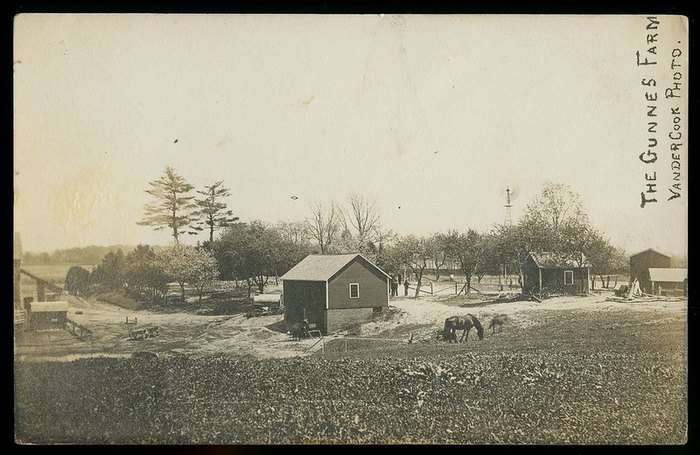
Immediately, all fingers began to point to Ray Lamphere, Gunness’s jealous ex-farmhand. He had been seen leaving the area of the farm just before it caught fire. He also was threatening Gunness around this time. Therefore, he was quickly arrested and charged with arson and murder.
The mystery of the headless body remained – was it actually Gunness? Multiple local farmers who knew her testified that the body they saw wasn’t hers. Without a head to identify, the investigation was stymied, despite many coming to their own conclusion that the body was not hers.
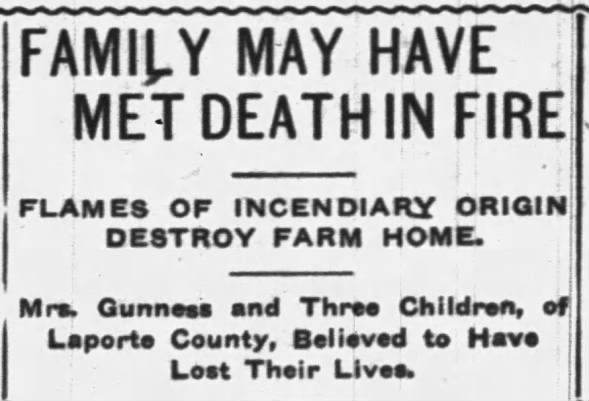
Upon hearing of the fire, Asle Helgelien, the brother of Gunness’ victim, Andrew, came to La Porte hoping to find clues about his brother’s disappearance. He and Joe Maxson, the farmhand, decided to dig around the property, targeting spots where Maxson knew Belle would bury trash.
In one of these many ‘depressions’ in the ground, the two eventually discovered Andrew’s body in a gunny sack. His brother was able to identify the remains. The digging continued, and altogether they uncovered at least 13 bodies.
In another depression, officials found the body of Gunness’ daughter, Jennie. And in a separate patch of land, two unidentified children. Body after body was discovered all over the Gunness property. This astounded the local authorities as well as her LaPorte neighbors. Immediately, the identity of the headless body found in the burnt farmhouse seemed even more suspicious and disconcerting.
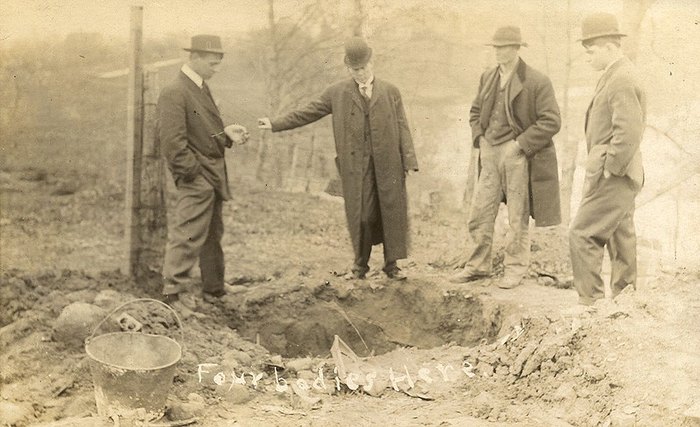
The Mysterious Fate of Belle Gunness
Despite the discovery of more than a dozen bodies, as well as Lamphere’s confession to authorities, Gunness’s death was never officially confirmed, and she was never seen or found. Her escape and disappearance continue to baffle investigators and amateur sleuths alike, making her fate one of the most mysterious, intriguing tales of any serial killer in history.
Throughout his trial, and through the rest of his life, Ray Lamphere would continue to plead that he was not guilty of arson or murder. Before he died in prison, Lamphere revealed that Gunness had planned the entire event and skipped town after she withdrew most of the money from her bank accounts.
Without a head, he was never charged with the murder. Given her multitude of victims – Lamphere estimated over 40 himself – many would come to believe his version of events.
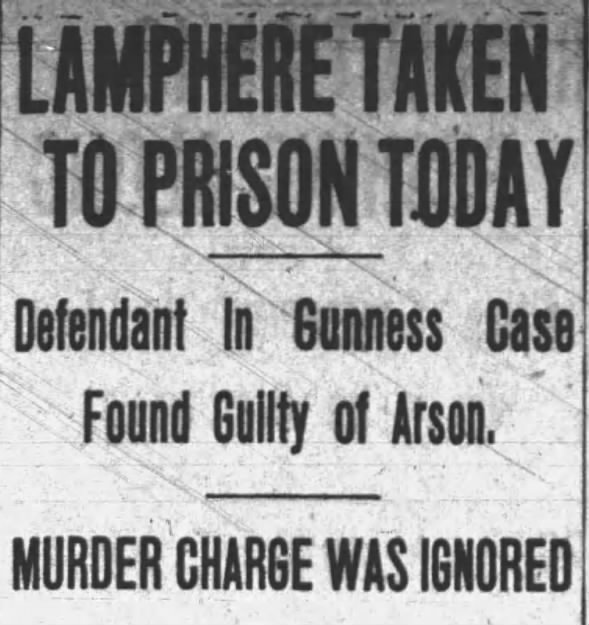
Throughout her life, Belle Gunness developed a knack for staging fires and claiming insurance payments. It is not such a stretch to believe that she had the wherewithal and ability to stage her death and take flight.
For decades after the fire, Gunness was sighted across the United States. Yet, these alleged sightings could never be confirmed or verified. From Chicago to San Francisco; Los Angeles to New York, the sightings of Gunness continued – two a month on average.
The actual fate of Belle Gunness is, and likely will remain a mystery. Even residents of La Porte, Indiana hold differing opinions about what happened.
A potential sighting of her occurred in 1931 when a woman named “Esther Carlson” was taken into custody in Los Angeles. She was arrested for poisoning, not unlike Gunness’ typical tactics. Two individuals who had known Gunness claimed to have recognized her from the photographs, but the claim was never substantiated.
Carlson passed away while awaiting trial, so we may never know the truth.
Unanswered Questions and Gunness’ Legacy
The story of Belle Gunness leaves us with many unanswered questions. What were her motivations, the details of her crimes, and the number of victims she killed? Was she driven by greed, the desire for a better life, or more sinister motivations? Did she enjoy killing?
Despite a normal, unsuspecting early life, immigrating to the US in search of a better life, Gunness’ path quickly veered off the rails. She became one of the most infamous female serial killers in American history.
References
Blanco, Juan Ignacio. “Belle Gunness.” Murderpedia, the Encyclopedia of Murderers, https://murderpedia.org/female.G/g/gunness-belle.htm.
Biography.com Editors. “Belle Gunness Biography.” Biography.com, A&E Networks Television, 18 Mar. 2021, https://www.biography.com/crime/belle-gunness.
Johnson, Bruce R. “Belle Gunness.” La Porte County Historical Society Museum, La Porte County Historical Society, Inc., 13 Aug. 2021, https://laportecountyhistory.org/exhibits/belle-gunness/.

